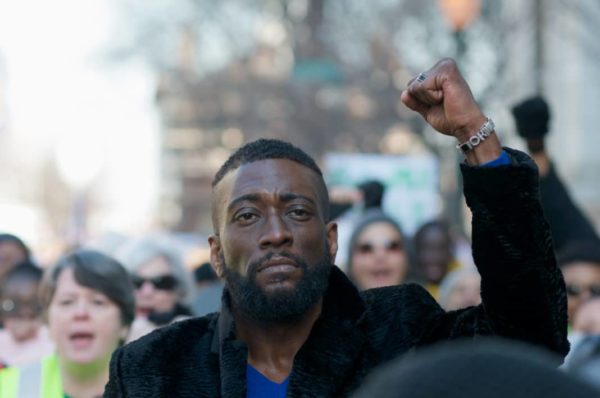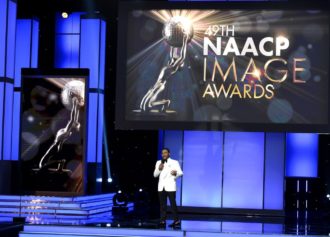
Prentice Bush raises his fist as he joins a crowd of hundreds protesting Right-Wing extremism at march in Philadelphia, on Martin Luther King Jr. Day, January 16, 2017.
(Photo by Bastiaan Slabbers/NurPhoto via Getty Images)
“Oh yes, Great White Father, you did surprise us with one thing you did … but it wasn’t you killing us, it wasn’t you raping our women or killing our kids or burning our village down … that didn’t surprise us. What surprised us, Great White Father, was that after you done all them vicious things to us, you go all over the world trying to convince people that the Red Man is the savage.”
— Dick Gregory, “Not Gonna Be Your Injun No More,” San Francisco State 1971
Their impossible plot was likely first hatched within the dark Hadean hull of any one of a multitude of westbound vessels stocked to the brim with wretched human cargo, amidst high seas and low spirits, upon the nauseating and relentless contractions of the mighty Atlantic.
The terrorists were far from organized. They bore a variety of tongues, tribal markings, and customs, be they Yoruba, Mande, Ewe, or any number of established African peoples. Prior to now, before their rich dark flesh — the one thing they had in common — had suddenly rendered them victims, they hardly could have recognized their sunbaked visages would be their downfall. Their position and condition were wholly compromised, weakened physically and spiritually from malnutrition, disease and trauma, the trauma of a world plunged into darkness, an indelible darkness dimming their ability to see their own ravaged, withering bodies or their shared blood oozing from infected wounds, collecting below and mixing with excrement to form a muddy crimson paste, a vile bedding upon which they had no choice but to lay their weary heads. The horrific stench revealed what the darkness concealed, confirming hull and hell to be no more than a letter apart.
Yet, somehow, despite the darkness, their wretched condition and the daunting barriers of language and culture, they mobilized. And when the slimmest of chances presented itself, the unlikeliest of opportunities to reaffirm their divine right to life and self-determination bestowed upon them by their Creator, they rose from the dark bowels of the hell-bent vessel and took to the decks, this manacled, malnourished and bloodied band of terrorists, to wage an impossible all-or-nothing battle, one destined to go unrecorded, in the midst of shark-infested waters hundreds of miles away from the rich fertile soil they called home.
Indeed, these were our first terrorists, our first dark threat to American soil, although not yet upon American soil, American soil that had yet to be regarded as such. They were the terror, despite being violently abducted from their lush ancient land, permanently severed from all who they loved and cared about, and from all who loved and cared about them. Though beaten, butchered, raped and sodomized, often in the presence of those loved ones cursed by the same fate, they were the terror. Though dehumanized, enslaved and tortured by a foreign, pale and brutish people, they were the terror.
Fast-forward over heart-stopping waves, endless nautical miles, and godless, backbreaking centuries of enslavement and sharecropping to arrive in the 20th century, just before the second world war, at a two-story home in Atlanta where a terrified twelve-year old named Michael had climbed the stairs and leapt from a bedroom window in an attempt to take his own life. The distraught and guilt-ridden pre-teen had been unable to sleep for days since the death of his grandmother. After sneaking out of the house a week earlier to attend a parade against his parents’ wishes, his little brother — the one he was supposed to be home watching — slid down a bannister and accidentally knocked their elderly grandmother unconscious. The senior would subsequently die from a heart attack largely unrelated to the accident, yet this wouldn’t stop the young Michael from associating his rebellious actions with his grandmother’s death. Fortunately, the troubled boy would survive the suicide attempt without major injury.
Unfortunately, the threat of suicide would continue to haunt Michael well into his adult years, even after maturing into a world-renowned leader, becoming a human rights icon, and changing his name, like his father Michael Sr. before him, to that of the historic religious reformer, Martin Luther. However, this time around, in a bizarre twist, the suicide threat was an external one.
In November 1964, just after the Civil Rights Act he helped champion passed Congress, and he became the youngest man ever awarded the Nobel Peace Prize, 35-year old Martin Luther King received a yellowed, typed letter accusing him of a variety of “evil” and adulterous sexual acts, telling him, “You Are Done” and encouraging him to kill himself. Already receiving death threats on a daily basis and the target of numerous assassination attempts, King immediately told close friends his belief that FBI director J. Edgar Hoover was behind the letter. A decade later, King’s suspicions were confirmed posthumously by the U.S. Senate Church Committee on intelligence.
His own government would continue to hound him throughout the 1960s as King became more outspoken against the lack of enforcement of equal rights in the South, the inequities of capitalism, the distribution of American wealth, and the Vietnam War. King criticized his country’s “immoral” involvement in the Vietnam War while labeling America “the greatest purveyor of violence in the world.” He insisted the nation’s economy “created beggars” while encouraging greed and excess on the backs of the poor. King’s words and actions had him labeled an enemy by his own government as President Lyndon Johnson designated him “persona non grata” and Hoover’s FBI branded him the “most dangerous man in America.”
King had never set out to become a terrorist. Far from fearless, King was known to suffer through bouts of depression and anxiety. He was by no means beyond doubting and questioning his own role or the daunting mantle of leadership he’d assumed. Hoover played upon this. And yet King’s training and faith would consistently trump his insecurities as he challenged his fears and continued up the mountain despite the inescapable terror within.
“It may be true that the law cannot make a man love me, but it can keep him from lynching me, and I think that’s pretty important.”
—Martin Luther King Jr.
It’s an oft-repeated theme in an epic-yet-skewed American drama where darker-hued protagonists are brutally victimized and oppressed and then, upon acting to defend or liberate themselves — or merely reclaim their basic humanity — are labeled terrorists, a loaded designation commonly bearing the weight of both the dominant narrative and the apparatus of the American police state. It is a designation as stigmatizing as it is subjective, as Hawthornean as it is malleable. Its purpose is to render its targets inanimate, as expendable objects lacking the capacity for both feeling and humanity. Its aim is to provoke and justify a draconian response, one depicted in gruesome black-and-white images of Southern families, children in tow, smiling at the camera as castrated African-American men dangle lifelessly from a tree; one reinforced by multiple rounds of state-sponsored bullets pumped into the unarmed and dying Black bodies of Ferguson, of Baltimore, of Seattle, of Falcon Heights, of Los Angeles, of New York, of far too many cities to invoke. It is a moniker designed to first neuter the community-supporting activities and traction of a collective like Black Lives Matter through repetition and the cumulative weight of cognitive association before wholly demonizing its target and justifying its merciless slaughter. Indeed, the American terror mill has long been powered by bodies of color.
Consistently, when it comes to our modern federal police state, King was, by no means, the first Black mass movement leader to be regarded a dangerous and subversive national threat. In fact, the very apparatus itself — the government surveillance, badgering, intimidation and set-ups that would eventually emerge as COINTELPRO — was forged from the American quest to prevent the ‘rise of a Black Messiah’ through the orchestrated downfall of early 20th century mass-movement leader Marcus Garvey. And it would continue upon King’s untimely demise to further wreak havoc within the ranks of the Black Panther Party, those iconic freedom fighters seldom referred to by their full name, “The Black Panther Party for Self-Defense.” Indeed, their very purpose was contained in the final hyphenated term of their original handle.
The Panthers’ initial ten-point platform was rife with subversive declarations, ones now expected of such dangerous African-American organizations that dare mobilize for self-defense and community empowerment, and against white supremacy, human rights violations and police brutality. While feeding and educating hungry children and families for free — and challenging the proliferation of an American military-industrial complex abroad and racialized incarceration practices at home — this “radical” organization had the audacity to demand freedom and self-determination, employment, an end to the capitalistic pillaging of urban communities, decent housing, authentic education, military exemption, an end to police brutality, an end to unjust incarceration, fair trials by a racially representative jury, and, ultimately, “land, bread, housing, education, clothing, justice and peace.”
Obviously, in America, such subversion could not be tolerated. Accordingly, they, like King and Garvey, needed to be stopped at all costs through the endless authority, resources and apparatus of the FBI, its collusion with local law enforcement and select national media. It was a media far too willing to join the cause for the sake of order and supremacy and to protect the necessary story white America told itself about itself, and about its dark inhabitants, their moral ineptitude, their apparent inferiority, their inherent slothfulness. This racialized perpetuation of fake news, long before fake news became fake news, was an essential component of the terror myth, a necessary license for responding with unmitigated violence and barbarism, blood and fury. After all, these radicals had to be stopped. For they were the terror.
Indeed, for a country unwilling to recognize their full humanity, they were just that, from those early sea-bound African resisters through a lengthy list of persona non gratas with names like Gabriel Prosser, Denmark Vesey, David Walker, Nat Turner, John Horse, Joseph Cinqué, Harriet Tubman, Sojourner Truth, Ida B. Wells, Robert Williams, Rosa Parks, Malcolm X, Angela Davis, Geronimo Ji-Jaga Pratt, Assata Shakur and, yes, Martin Luther King Jr.
Within the context of this long lineage of resistance, and the American state that tried to abort it, perhaps King’s greatest legacy rings through his selfless quest to challenge both his own fear and the darkened soul of a troubled nation despite the inescapable terror within.


